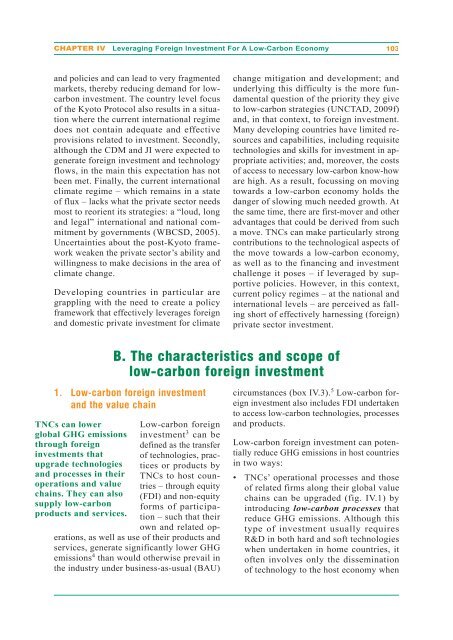UN World Investment Report 2010 - Office of Trade Negotiations
UN World Investment Report 2010 - Office of Trade Negotiations
UN World Investment Report 2010 - Office of Trade Negotiations
You also want an ePaper? Increase the reach of your titles
YUMPU automatically turns print PDFs into web optimized ePapers that Google loves.
CHAPTER IV Leveraging Foreign <strong>Investment</strong> For A Low-Carbon Economy 103<br />
and policies and can lead to very fragmented<br />
markets, thereby reducing demand for lowcarbon<br />
investment. The country level focus<br />
<strong>of</strong> the Kyoto Protocol also results in a situation<br />
where the current international regime<br />
does not contain adequate and effective<br />
provisions related to investment. Secondly,<br />
although the CDM and JI were expected to<br />
generate foreign investment and technology<br />
flows, in the main this expectation has not<br />
been met. Finally, the current international<br />
climate regime – which remains in a state<br />
<strong>of</strong> flux – lacks what the private sector needs<br />
most to reorient its strategies: a “loud, long<br />
and legal” international and national commitment<br />
by governments (WBCSD, 2005).<br />
Uncertainties about the post-Kyoto framework<br />
weaken the private sector’s ability and<br />
willingness to make decisions in the area <strong>of</strong><br />
climate change.<br />
Developing countries in particular are<br />
grappling with the need to create a policy<br />
framework that effectively leverages foreign<br />
and domestic private investment for climate<br />
change mitigation and development; and<br />
underlying this difficulty is the more fundamental<br />
question <strong>of</strong> the priority they give<br />
to low-carbon strategies (<strong>UN</strong>CTAD, 2009f)<br />
and, in that context, to foreign investment.<br />
Many developing countries have limited resources<br />
and capabilities, including requisite<br />
technologies and skills for investment in appropriate<br />
activities; and, moreover, the costs<br />
<strong>of</strong> access to necessary low-carbon know-how<br />
are high. As a result, focussing on moving<br />
towards a low-carbon economy holds the<br />
danger <strong>of</strong> slowing much needed growth. At<br />
the same time, there are first-mover and other<br />
advantages that could be derived from such<br />
a move. TNCs can make particularly strong<br />
contributions to the technological aspects <strong>of</strong><br />
the move towards a low-carbon economy,<br />
as well as to the financing and investment<br />
challenge it poses – if leveraged by supportive<br />
policies. However, in this context,<br />
current policy regimes – at the national and<br />
international levels – are perceived as falling<br />
short <strong>of</strong> effectively harnessing (foreign)<br />
private sector investment.<br />
B. The characteristics and scope <strong>of</strong><br />
low-carbon foreign investment<br />
1. Low-carbon foreign investment<br />
and the value chain<br />
Low-carbon foreign<br />
investment3 can be<br />
defined as the transfer<br />
<strong>of</strong> technologies, practices<br />
or products by<br />
TNCs to host countries<br />
– through equity<br />
(FDI) and non-equity<br />
forms <strong>of</strong> participation<br />
– such that their<br />
own and related operations,<br />
as well as use <strong>of</strong> their products and<br />
services, generate significantly lower GHG<br />
emissions4 TNCs can lower<br />
global GHG emissions<br />
through foreign<br />
investments that<br />
upgrade technologies<br />
and processes in their<br />
operations and value<br />
chains. They can also<br />
supply low-carbon<br />
products and services.<br />
than would otherwise prevail in<br />
the industry under business-as-usual (BAU)<br />
circumstances (box IV.3). 5 Low-carbon foreign<br />
investment also includes FDI undertaken<br />
to access low-carbon technologies, processes<br />
and products.<br />
Low-carbon foreign investment can potentially<br />
reduce GHG emissions in host countries<br />
in two ways:<br />
•<br />
TNCs’ operational processes and those<br />
<strong>of</strong> related firms along their global value<br />
chains can be upgraded (fig. IV.1) by<br />
introducing low-carbon processes that<br />
reduce GHG emissions. Although this<br />
type <strong>of</strong> investment usually requires<br />
R&D in both hard and s<strong>of</strong>t technologies<br />
when undertaken in home countries, it<br />
<strong>of</strong>ten involves only the dissemination<br />
<strong>of</strong> technology to the host economy when

















